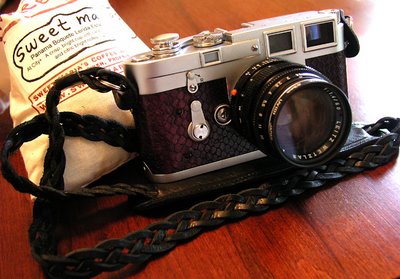It just arrived yesterday from
Tony Rose of Popflash photo. I have been puttering around, getting comfortable with the camera, and I have to say I am pretty impressed.
I had been looking to get a new digital, to replace my aging Olympus C5050. It is still a very good camera, but the shutter lag is just annoying. Initially, I had planned on a DSLR, but at the moment, what with Sony joining the fray with the Alpha, I think I would wait a little bit for the dust to settle.
I love, and still use quite a bit, the Ricoh GR-1 film camera, with its legendary 28mm leica-beater lens. Recently, there has been quite some talk about the Ricoh digital GR, and to make a long story short, I ended up with one.
There are write-ups online about the new 8mp Ricoh GR Digital compact, so this isn't going to be another one. Here's why I like it:
1. Excellent user interface. No need to go into menus to access frequently used controls.
2. Compact design. Just about 1/2 inch thick, and actually a few millimeters shorter than the already compact GR-1. Roughly the size of a deck of playing cards.
3. Build quality. Just like the GR film camera. Magnesium, if I am not mistaken.
4. Excellent 28mm equivalent f/2.4 lens.
5. Fast. Virtually no (0.1 sec) shutter lag.
6. Superior resolution, with no purple-fringing or oversharpening. Colors are natural, not overdone.
7. Good high iso performance. "Film-like" noise (okay... "grain") at high iso.
Sure there are weaknesses, but here are my thoughts:
1. I don't want or need RAW in a point and shoot, so I don't mind the long write times. With a DSLR, I would shoot RAW. If I needed maximum image quality, I would shoot raw, or medium format.
2. My main uses are for candid/street shooting, and mostly travel photography. Compactness is very important. I am tired of walking around all day with a heavy camera and fast lens around my neck or on a shoulder, and a bagful of lenses.
3. My main output is: online, 8 x 10 b& w inkjet prints for my "keepers," and a bunch of 4x6's or 5x7's for my wife to make a scrapbook/album. Eight megapixel jpegs are just fine for that.
4. I like low light and night photography, so the fast lens and high iso performance are welcome.
5. I don't mind the lack of an optical viewfinder. Most, if not all, digital p&s finders are small and squinty anyway. In fact, DSLR's VF's are small and squinty too. I am fine with the LCD back, and in the future may consider a compact shoemount VF.
6. I don't shoot a lot of flash, but it would have been nice if the GRD had flash compensation.
I haven't had time to go out and properly shoot with this camera yet these past couple of days, but here are a few examples. The first at iso 400, the last two at iso 800. Not bad.














